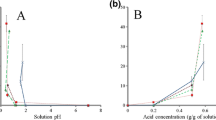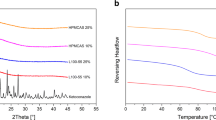Abstract
The aim of this paper is to investigate the physicochemical properties of binary amorphous dispersions of poorly soluble sulfonamide/polymeric excipient prepared by ball milling. The sulfonamides selected were sulfathiazole (STZ), sulfadimidine (SDM), sulfamerazine (SMZ) and sulfadiazine (SDZ). The excipients were polyvinylpyrrolidone (PVP) and polyvinyl caprolactam-polyvinyl acetate-polyethylene glycol graft co-polymer, commercially known as Soluplus®. Co-milled systems were characterised by powder X-ray diffraction and differential scanning calorimetry. PVP was shown to form amorphous dispersions over a wider composition range than Soluplus® for the four sulfonamides tested. Moreover, amorphous dispersions made with PVP were homogeneous [single glass transition (Tg)], while amorphous dispersions made from Soluplus® were heterogeneous (two Tgs). This behaviour is consistent with the fact that all the sulfonamides tested presented a lower solubility in Soluplus® than in PVP, as evidenced by Flory–Huggins parameters determined. Amorphous dispersions of SDM with Soluplus® could be produced even though SDM does not amorphise alone upon milling and Soluplus® presents Tg at a lower temperature than SDM. Amorphous dispersions of SMZ could be prepared with a lower excipient concentration compared to STZ, SDM and SDZ, which may reflect the one-dimensional H-bonding network in SMZ compared to the 2D or 3D H-bonding network found in the other sulfonamides. Stability tests (60% RH/25°C) revealed that dispersions made with Soluplus® remained dry and powdery compared to those made with PVP that formed a sticky paste in less than 2 weeks, indicating a possible advantage of using Soluplus® in terms of increased physical stability under high humidity storage conditions.






Similar content being viewed by others
REFERENCES
Murdande SB, Pikal MJ, Shanker RM, Bogner RH. Solubility advantage of amorphous pharmaceuticals: I. A thermodynamic analysis. J Pharm Sci. 2010;99(3):1254–64.
Patterson JE, James MB, Forster AH, Lancaster RW, Butler JM, Rades T. Preparation of glass solutions of three poorly water soluble drugs by spray drying, melt extrusion and ball milling. Int J Pharm. 2007;336(1):22–34.
Greco K, Bogner R. Crystallization of amorphous indomethacin during dissolution: effect of processing and annealing. Mol Pharm. 2010;7(5):1406–18.
Bogner RH, Murdande SB, Pikal MJ, Shanker RM. Solubility advantage of amorphous pharmaceuticals: II. Application of quantitative thermodynamic relationships for prediction of solubility enhancement in structurally diverse insoluble pharmaceuticals. Pharm Res. 2010;27(12):2704–14.
Bhugra C, Pikal MJ. Role of thermodynamic, molecular, and kinetic factors in crystallization from the amorphous state. J Pharm Sci. 2008;97(4):1329–49.
Caron V, Bhugra C, Pikal MJ. Prediction of onset of crystallization in amorphous pharmaceutical systems: phenobarbital, nifedipine/PVP, and phenobarbital/PVP. J Pharm Sci. 2010;99(9):3887–900.
Tajber L, Corrigan OI, Healy AM. Physicochemical evaluation of PVP-thiazide diuretic interactions induced by processing—analysis of glass transition composition relationships. Eur J Pharm Sci. 2005;24(5):553–63.
Hancock BC, Shamblin SL, Zografi G. Molecular mobility of amorphous pharmaceutical solids below their glass transition temperatures. Pharm Res. 1995;12(6):799–806.
Qian F, Huang J, Hussain MA. Drug–polymer solubility and miscibility: stability consideration and practical challenges in amorphous solid dispersion development. J Pharm Sci. 2010;99(7):2941–7.
Caron V, Tajber L, Corrigan OI, Healy AM. A comparison of spray drying and milling in the production of amorphous dispersions of sulfathiazole/polyvinylpyrrolidone and sulfadimidine/polyvinylpyrrolidone. Mol Pharm. 2011;8(2):532–42.
Tian Y, Booth J, Meehan E, Jones DS, Li S, Andrews GP. Construction of drug–polymer thermodynamic phase diagrams using Flory–Huggins interaction theory: identifying the relevance of temperature and drug weight fraction to phase separation within solid dispersions. Mol Pharm. 2012. doi:10.1021/mp300386v.
Andrews GP, Jones DS, Abu-Diak O, Margetson DN, McAllister MS. Hot-melt extrusion: an emerging drug delivery technology. Pharm Technol Eur. 2009;21(1):18–23.
Andrews GP, Abu-Diak O, Kusmanto F, Hornsby P, Hui Z, Jones DS. Physicochemical characterization and drug-release properties of celecoxib hot-melt extruded glass solutions. J Pharm Pharmacol. 2010;62(11):1580–90.
Corrigan OI, Holohan EM. Amorphous spray-dried hydroflumethiazide-polyvinylpyrrolidone systems: physicochemical properties. J Pharm Pharmacol. 1984;36(4):217–21.
Corrigan DO, Corrigan OI, Healy AM. Predicting the physical state of spray dried composites: salbutamol sulphate/lactose and salbutamol sulphate/polyethylene glycol co-spray dried systems. Int J Pharm. 2004;273(1–2):171–82.
Lu X, Pikal MJ. Freeze-drying of mannitol-trehalose-sodium chloride-based formulations: the impact of annealing on dry layer resistance to mass transfer and cake structure. Pharm Dev Technol. 2004;9(1):85–95.
Luthra SA, Hodge IM, Pikal MJ. Investigation of the impact of annealing on global molecular mobility in glasses: optimization for stabilization of amorphous pharmaceuticals. J Pharm Sci. 2008;97(9):3865–82.
Brittain HG. Effects of mechanical processing on phase composition. J Pharm Sci. 2002;91(7):1573–80.
Willart JF, Descamps M. Solid state amorphization of pharmaceuticals. Mol Pharm. 2008;5(6):905–20.
Willart JF, Caron V, Descamps M. Transformations of crystalline sugars upon milling. J Therm Anal Calorim. 2007;90(1):125–30.
Willart JF, Descamps N, Caron V, Capet F, Danede F, Descamps M. Formation of lactose-mannitol molecular alloys by solid state vitrification. Solid State Commun. 2006;138(4):194–9.
Caron V, Willart JF, Danede F, Descamps M. The implication of the glass transition in the formation of trehalose/mannitol molecular alloys by ball milling. Solid State Commun. 2007;144(7–8):288–92.
Willart JF, Caron V, Lefort R, Danede F, Prevost D, Descamps M. Athermal character of the solid state amorphization of lactose induced by ball milling. Solid State Commun. 2004;132(10):693–6.
Zhang GGZ, Gu C, Zell MT, Todd Burkhardt R, Munson EJ, Grant DJW. Crystallization and transitions of sulfamerazine polymorphs. J Pharm Sci. 2002;91(4):1089–100.
Yang SS, Guillory JK. Polymorphism in sulfonamides. J Pharm Sci. 1972;61:26–40.
Mesley RJ, Houghton EE. Infrared identification of pharmaceutically important sulphonamides with particular reference to the occurrence of polymorphism. J Pharm Pharmacol. 1967;19:295–304.
Occhipinti V, Djuric D. A new excipient for hot-melt extrusion. Manuf Chem. 2010;81–82:36–8.
Hardung H, Djuric D, Ali S. Combining HME & solubilization: Soluplus®—the solid solution. Drug Deliv Technol. 2010;10(3):20–7.
Tao J, Sun Y, Zhang GGZ, Yu L. Solubility of small-molecule crystals in polymers: d -mannitol in PVP, indomethacin in PVP/VA, and nifedipine in PVP/VA. Pharm Res. 2009;26(4):855–64.
Langford JI, Louer D. Powder diffraction. Rep Prog Phys. 1996;59(2):131–234.
Louer D. Advances in powder diffraction analysis. Acta Crystallogr A. 1998;54(6):922–33.
Dujardin N, Willart JF, Dudognon E, Hédoux A, Guinet Y, Paccou L, et al. Solid state vitrification of crystalline α and β-D-glucose by mechanical milling. Solid State Commun. 2008;148(1–2):78–82.
Desprez S, Descamps M. Transformations of glassy indomethacin induced by ball-milling. J Non-Cryst Solids. 2006;352(42–49 SPEC. ISS):4480–5.
Zeitler JA, Newnham DA, Taday PF, Threlfall TL, Lancaster RW, Berg RW, et al. Characterization of temperature-induced phase transitions in five polymorphic forms of sulfathiazole by terahertz pulsed spectroscopy and differential scanning calorimetry. J Pharm Sci. 2006;95(11):2486–98.
Debenedetti PG, Stillinger FH. Supercooled liquids and the glass transition. Nature. 2001;410(6825):259–67.
Sun Y, Tao J, Zhang GGZ, Yu L. Solubilities of crystalline drugs in polymers: an improved analytical method and comparison of solubilities of indomethacin and nifedipine in PVP, PVP/VA, and PVAc. J Pharm Sci. 2010;99(9):4023–31.
Flory PJ. Principle of polymer chemistry. Ithaca: Cornell University Press; 1953.
Gordon M, Taylor JS. Ideal copolymers and the second order transitions of synthetic rubbers I. Non-crystalline copolymers. J Appl Chem. 1952;2:493–500.
Simha R, Boyer RF. On a general relation involving glass temperature and coefficient of expansion of polymers. J Chem Phys. 1962;37(5):1003–7.
Descamps M, Willart JF, Dudognon E, Caron V. Transformation of pharmaceutical compounds upon milling and comilling: the role of Tg. J Pharm Sci. 2007;96(5):1398–407.
Willart JF, Dujardin N, Dudognon E, Danede F, Descamps M. Amorphization of sugar hydrates upon milling. Carbohydr Res. 2010;345(11):1613–6.
Sun C, Grant DJW. Influence of crystal structure on the tableting properties of sulfamerazine polymorphs. Pharm Res. 2001;18(3):274–80.
ACKNOWLEDGMENTS
This paper is based upon works supported by the Science Foundation Ireland under grant no. [07/SRC/B1158] as part of the Solid State Pharmaceutical Cluster (SSPC).
Author information
Authors and Affiliations
Corresponding author
Rights and permissions
About this article
Cite this article
Caron, V., Hu, Y., Tajber, L. et al. Amorphous Solid Dispersions of Sulfonamide/Soluplus® and Sulfonamide/PVP Prepared by Ball Milling. AAPS PharmSciTech 14, 464–474 (2013). https://doi.org/10.1208/s12249-013-9931-7
Received:
Accepted:
Published:
Issue Date:
DOI: https://doi.org/10.1208/s12249-013-9931-7




